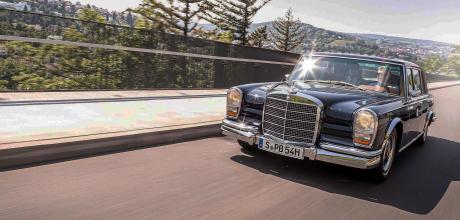1972 Mercedes-Benz 600 W100
60 years ago Mercedes-Benz defined a new era of luxury cars with its behemoth 600.Glen Waddington drives the choice of celebs and despots.
Photography Dino Eisele
Mercedes-Benz Heritage
THE BOSSES WHEELS
Celebrating 60 years of the ultimate limousine
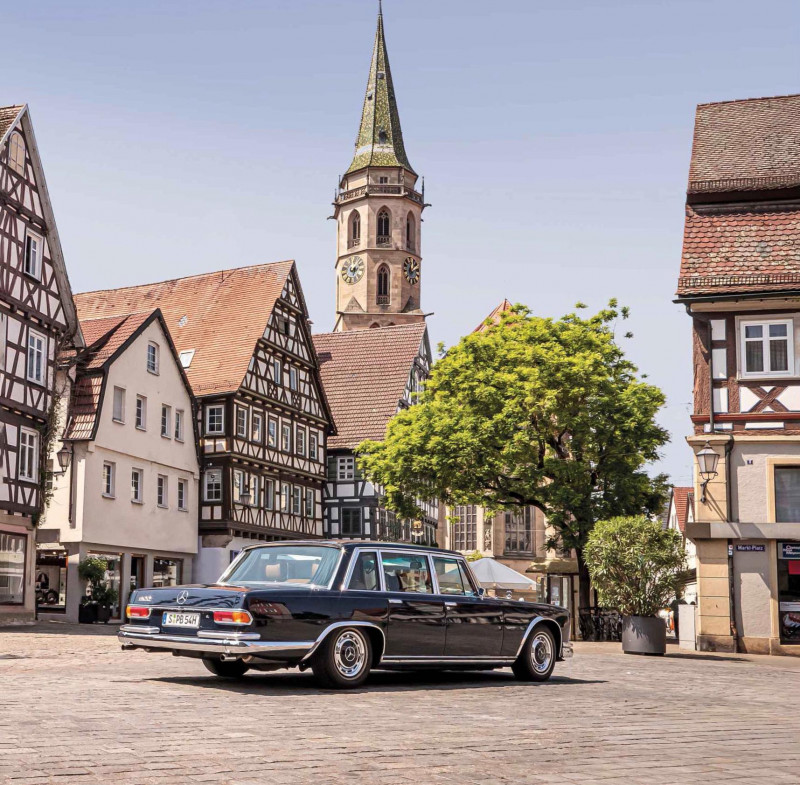
It’s significant that my passenger is Marcus Breitschwerdt. Not only because he is the boss of the Mercedes-Benz Museum, but because, as he says himself: I am the son of an engineer, the brother of an engineer — and a nephew of an engineer.’ His uncle was the late Werner Breitschwerdt, a key member of the team that developed the Mercedes-Benz 600 and who went on in 1983 to become Chairman of the Board of Management of the whole company. ‘We wanted to build a car that could do everything that was possible, and we wanted it to be able to do more than any other car, for the driver and the passenger,’ he said of the 600, shortly before he stepped down from that role in the late 1980s.
Marcus Breitschwerdt displays equally obvious pride. ‘It has a 250bhp V8, so it was as fast as a Porsche 911 yet also capable of carrying passengers in great comfort. It has power-assisted brakes, with dual calipers, so you can drive it quickly because you can also slow down in a short distance. There is air suspension, and high-pressure hydraulics move the windows, the seats, even the boot-lid. It was built for a very long life, so it is very strong and very safe.’
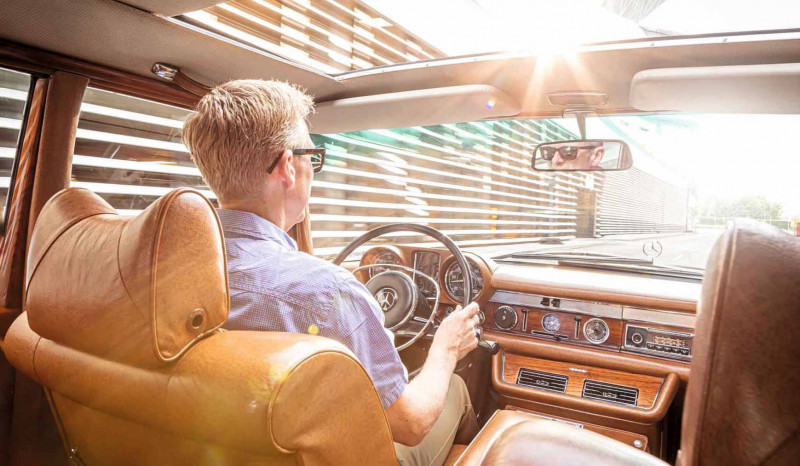
We are heading out of Stuttgart, away from the Mercedes-Benz Museum towards the nearby town of Schorndorf, birthplace of Gottlieb Daimler, founder of one of the two pioneering companies that merged in 1926 to become Daimler-Benz AG. You can find out more about Marcus Breitschwerdt and Daimler’s childhood home in the following article, as well as the impact Daimler’s background had on the direction Mercedes- Benz is now taking. For now, we relax serenely
at cruising speed, noting the exceptional calm of the big Merc’s ride, the ease with which its 6.3-litre V8 dispatches the kilometres, the accuracy of its steering, its arrow-like directional stability, the comforting embrace of its seat, and that the general silence is only remotely pierced by the merest flutter of air moving past the upright windscreen pillars. The thing feels bulletproof, as many 600s actually were.
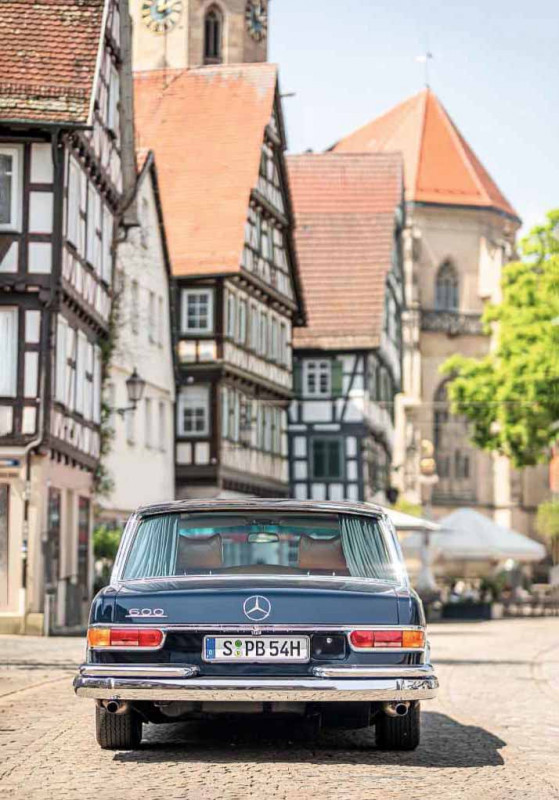
On which subject (and we’ll get this out of the way first): the 600 was known for its appeal among some of the less celebrated political leaders of times past. The list includes Brezhnev, Ceausescu, Idi Amin, Saddam Hussein, Chairman Mao… Doubtless the appointments and refinement appealed, but there’s no doubting a bulletproof car that was capable of getting out of its own way certainly had a USP.
Yet that list also includes Marshal Josip Broz Tito, and many considered Yugoslavia’s longterm leader to have been a benevolent dictator. After orchestrating a strike in the early 20th Century that caused his Czech employer to back down over bringing in cheaper, less skilled labour, he went to work for Skoda. And then he moved on to the Benz factory in Mannheim.
So perhaps it comes as less of a surprise to learn that Tito owned no fewer than four 1965 six-door long-wheelbase Pullmans, one of which was armoured, and two LWB Pullman landaulets, both of the rarer type (nine were built) with six doors and a folding roof that revealed two-thirds of the cabin, rather than only the rearmost section. Tito was the only statesman in the world who had two Pullman landaulets. Tito was clearly an enthusiast.
But for every tin-pot dictator there was a celebrity. Three of the Beatles had one (only Paul denied himself, presumably happy with the Aston Martin DBS he’d ordered in 1964, just before setting off on a world tour), as did Ronnie Wood, Eric Clapton, Pete Townshend and David Bowie. Elvis had three — he famously shot his De Tomaso Pantera, so let’s hope at least one of them was armour-plated. Coco Chanel, Aristotle Onassis and Jack Nicholson were also customers. And it’s said that a ride in Bobby Womack’s inspired Janis Joplin to sing her plaintive atonement. Clearly Womack wasn’t one of the friends who all drive Porsches.
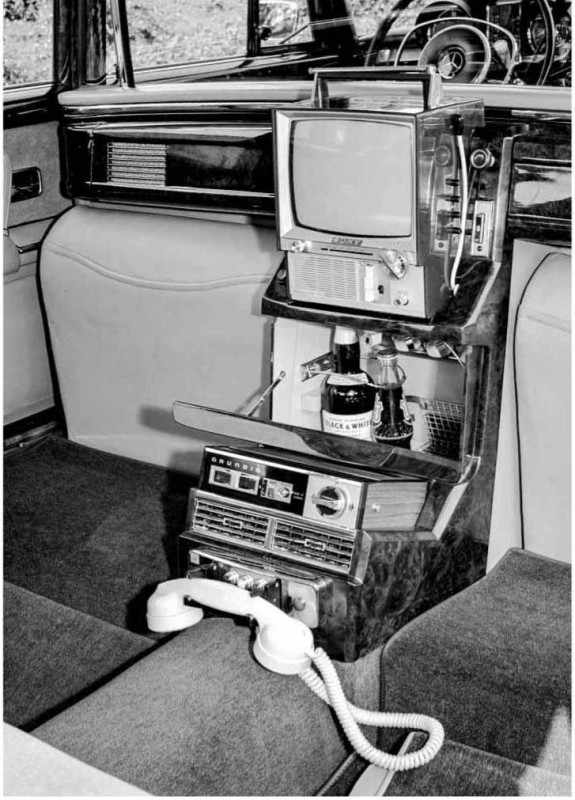
It’s now 60 years since the 600 was launched at the 1963 Frankfurt motor show. ‘Mercedes- Benz continues the company’s pre-war tradition of being represented in the small group of the world’s sensational prestige cars with a luxuriously equipped automobile that is extremely safe to drive,’ said the publicity, pithily. Over a 17-year career, 2677 were produced: 2190 Saloons, 304 Pullmans, 124 six-door Pullmans and 59 Landaulets.
They were all built at Mercedes-Benz’s Sindelfingen plant, a factory synonymous with the volume production of ultra-high-quality cars, not least several generations of S-Class. Each was handbuilt and, as customers were encouraged to personalise their car, most were unique. A long-wheelbase Landaulet was made for Pope Paul VI, and according to Mercedes- Benz’s archives, another — on a wheelbase 8.6in shorter than the saloon’s vast 126in — was built for a private customer. It was restored in the 1980s and is now in private ownership.
A two-door coupe on that shorter wheelbase was produced as a prototype in August 1965 to explore the potential of a successor to the 3008c of the 1950s, and was sold in the USA following a period in the testing department. It’s now in a private collection after being fully restored, though it likely spent time as the company wheels of chief design engineer Rudolf Uhlenhaut — and Prof Fritz Nallinger, head ofthe Mercedes research and development centre in the 1950s and ’60s, and the man who laid the 600’s foundations.
That concept started to take shape in 1955, when Nallinger defined a ‘future group of large touring and prestige vehicles’ as follows: ‘It gets automatic transmission, power-assisted steering and power-assisted brakes as standard. It is normally a six-seater. The frame floor system is designed to allow for creating a vehicle with three rows of seats by extending the wheelbase, if necessary.’ Oh, and six doors, for when four just weren’t enough.
Powering it would be the first V8 to feature in a Mercedes-Benz passenger car, the prototype of which ran on the test bench at the end of 1959. The production engine, designated M100, had a displacement of 6.3 litres and produced 250bhp — metric ones, that is, or 247 in old money. We won’t quibble. After all, that same engine went on to power the 300 SEL 6.3 W109, a proper hot-rod limo created for fun by Mercedes engineer Erich Waxenberger, which caused such a stir when launched at Geneva in 1968 that 6500 ended up being built.
The 600’s styling was led by design chief Friedrich Geiger, who had been responsible for the pre-war 540K and the inimitable 300SL Gullwing W198, though Frenchman Paul Bracq played a major role, heading up the Sindelfingen studio; he went on to be largely responsible for the W113 Pagoda and left to succeed Wilhelm Hofineister at BMW in 1970. So many iconic Mercedes-Benz cues are evident: long and low, sure, but with as much emphasis on the vertical as the horizontal. Note how the rearmost pillar sits directly over the wheelhub, placing the visual weight on the rear axle line. That makes for perfect stance. The 600 fits over its wheels like few other cars.
Yet Nallinger’s brief dictated that a large body and a refined drive should not be all that distinguished his vision of a grand Mercedes’, as he put it. Ease of use must take it into a new era, a different kind of luxury that would place quality and convenience above mere material opulence. Nallinger pitched an electrical system, developed by Werner Breitschwerdt, against a high-pressure hydraulic system, designed by Ernst Fiala.
The hydraulics won. Said Breitschwerdt: ‘You couldn’t have accommodated the many functions we wanted to do with the electrics back then. It was a space and weight problem because we would have needed a second battery, among other things. The high-pressure hydraulics developed had the advantage of getting by with small elements. The hydraulics were smaller, quieter and lighter than electrical motors of the time.’
The functions it would operate included closing the doors; the sliding sunroof drive; window lifts; the partition between driver and passenger compartments; boot-lid operation; opening and closing the heating and ventilation flaps; front and rear seat adjustment; damper adjustment; even the parking brake release.
Beyond that, head of passenger car development Rudolf Uhlenhaut set three further focal points: the highest passenger comfort, maximum safety and outstanding driving performance. The air suspension and adjustable dampers meant not only a smooth ride at all speeds but also handling at odds with the usual dynamics of a 20ft limousine. Special attention was paid to the brakes, too, with a dual-circuit hydraulic system and discs front and rear, clamped by dual calipers at the front. The 15in cross-ply tyres were specially designed and made by Fulda and Continental.
Drive the 600 and ‘unstressed’ is the word that springs to mind, which seems entirely appropriate: job done, Prof Nallinger. The racing driver Innes Ireland reported on a trip he made from Paris to London in Autocar, back in 1968, driving a six-door, long-wheelbase Pullman. ‘Within seconds we were cruising effortlessly and safely on our way, between 110 and 120mph. Although there was a strong crosswind of 60mph, the three tons of weight pressing down on the tyres seemed to cancel out the vast expanse of car presented to the wind, and we steered a very straight course.’
On a later trip, heading from his home in Wales to the Oulton Park race circuit, Ireland noted: ‘The response to the kickdown of the gears was instantaneous and she fairly leapt past slow-moving traffic — all 21 feet of her. But neither her length nor her width were ever an embarrassment, and I soon forgot that I had so much following on behind. She could be steered to a hair and I was amazed to find that her vast wheelbase did nothing to detract from cornering ability.’
The car you see here dates from 1972 and is a 600 saloon: standard 126in wheelbase (the Pullmans is fully 153.5in long!), four doors, plenty of lounging space for three in the rear compartment, and intended as the version that owners would drive themselves — so there’s no compartment division. It’s 218.1in long (Pullman: 245.7in), more than a foot longer than a Rolls-Royce Silver Shadow (203.5in).
Fire up the V8 and you’re aware of a very distant throb, more physical presence than audible sound. A wand to the right of the steering column accesses the four-speed automatic; ‘D’ selects with a slight clunk, you leave go of the brake pedal (no mush, there) and tread the broad organ-style throttle pedal. Whooshl You’re away with torquey ease, the big Bosch-injected V8 corralling 369lb ft at just 2800rpm to command the 600’s 2600kg dry weight with utter authority, spinning without vibration and heading towards its 5000rpm redline with little more than a background gasp.
‘A DIFFERENT KIND OF LUXURY THAT PLACED QUALITY AND CONVENIENCE ABOVE MERE MATERIAL OPULENCE’
Even given Nallinger’s lofty aims, it’s startling how the massive Merc never feels anything like as long and heavy as its stats say it should: it will go around corners flat, and the steering feels wieldy and manageable, neither too heavy nor too light, and without any slop at the wheel.
The suspension passes on only the suggestion of low-speed bumps and smooths out almost totally as you reach trunk road pace. There’s no hint of tyre noise or vibration from the surface, yet the big Merc has that feeling of being refined at source, rather than artificially silenced by wads of sound-deadening material. It is as impressive as it is enormous.
Likewise the build quality. Sure, the surfaces within, the steering wheel, the gear selector, they’re similar to those of other Mercs, but the heft with which each door clunks shut is like very little I’ve experienced elsewhere. The sense of security and finality it engenders is total, and the rigidity of the construction feels absolute.
There’s something that feels almost Jaguarlike about the way this car shrinks around you, yet your surroundings are nothing like as intimate. There’s wood panelling everywhere, and the dash and doors are clad in something that looks as though it might once have kept a lizard’s innards waterproof, though I’ve a fair suspicion that it’s petrochemical rather than faunal in origin.
There’s fun to be had with the on-board hydraulics: no waiting for a window to grind its way up and down to the accompaniment of motor noise. No, stab the button and the glass drops guillotine-like; flick back to lift and it sucks and thuds immediately back into place. But what’s really clever is that the controls are touch-sensitive, and a gentle caress will have the window gliding noiselessly to whichever position you’d prefer. Even the boot-lid swings open and shut at the touch of a chromed lever.
Of course, such a car would never come cheap — another reason why there was such an extensive list of, shall we say, ‘high-profile’ owners. The 1964 price list quoted DM 56,500 for the saloon — just over twice as much as the ‘regular’ range-topping W112 300 SEL, itself an expensive luxury car by any normal standards; the Pullman cost even more, at DM 63,500. Perhaps more tellingly, the Rolls-Royce Silver Shadow, which made its debut in 1965 at a UK price of £6557, sold in the US for just under $20,000 — where the 600 cost $22,000. When it appeared on the price list for the last time in 1979, the 600 saloon cost DM 144,368, the Pullman Saloon DM 165,760 and the six-door Pullman Limousine DM 175,728. By way of comparison, the recently introduced W116 450 SEL 6.9 was DM 78,999.
Today perhaps they’re less valuable than you’d imagine. The rare Landaulets are sought after, and one of Tito’s cars was advertised by Tom Hartley Jnr for more than £2m. However, a less well-known saloon might be expected to sell for south of £100,000, and that makes it far less expensive than one of Mercedes-Benz’s current big saloons.
All told, that’s not such a high price for something that was designed from the outset to be the greatest car of its type. A car so grand that even the traditional Mercedes gun-sight on the grille had to be scaled-up by 20%.
‘IT HAS THAT FEELING OF BEING REFINED AT SOURCE, RATHER THAN ARTIFICIALLY SILENCED’
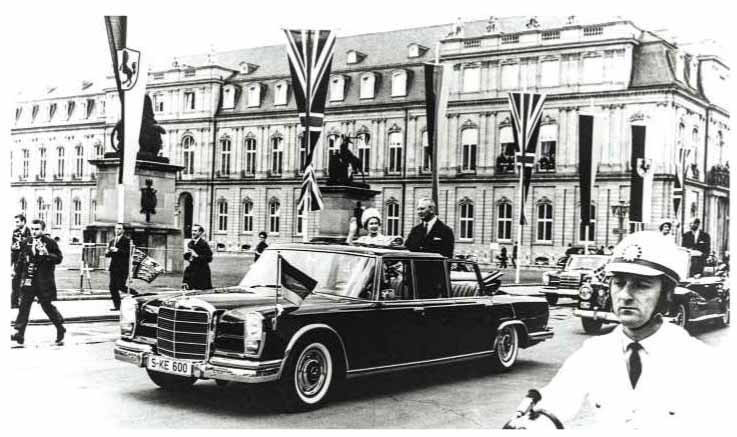
Left and right — Even the chauffeur gets a comfortable seat; in the rear compartment a TV, bar, tape recorder and radio telephone were optional extras — truly revolutionary for 1963.
Above and left Queen Elizabeth II and the Prime Minister of Baden-Wiirttemberg, Kurt Georg Kiesinger, on a state visit to Stuttgart in 1965 in a Pullman Landaulet; today in Schorndorf.
TECHNICAL DATA 1972 Mercedes-Benz 600 W100
- Engine 6332cc V8, OHC per bank, Bosch fuel injection
- Max Power 247bhp @ 4000rpm
- Max Torque 369lb ft @ 2800rpm
- Transmission Four-speed automatic, rear-wheel drive
- Steering Recirculating ball, power-assisted
- Suspension Front: double wishbones, air springs with integrated damping, rubber assisters, anti-roll bar. Rear: low-pivot swing axle, radius arms, self-levelling air springs with integrated damping, rubber assisters, anti-roll bar
- Brakes Discs, powered
- Weight 2600kg (dry)
- Top speed 127mph


